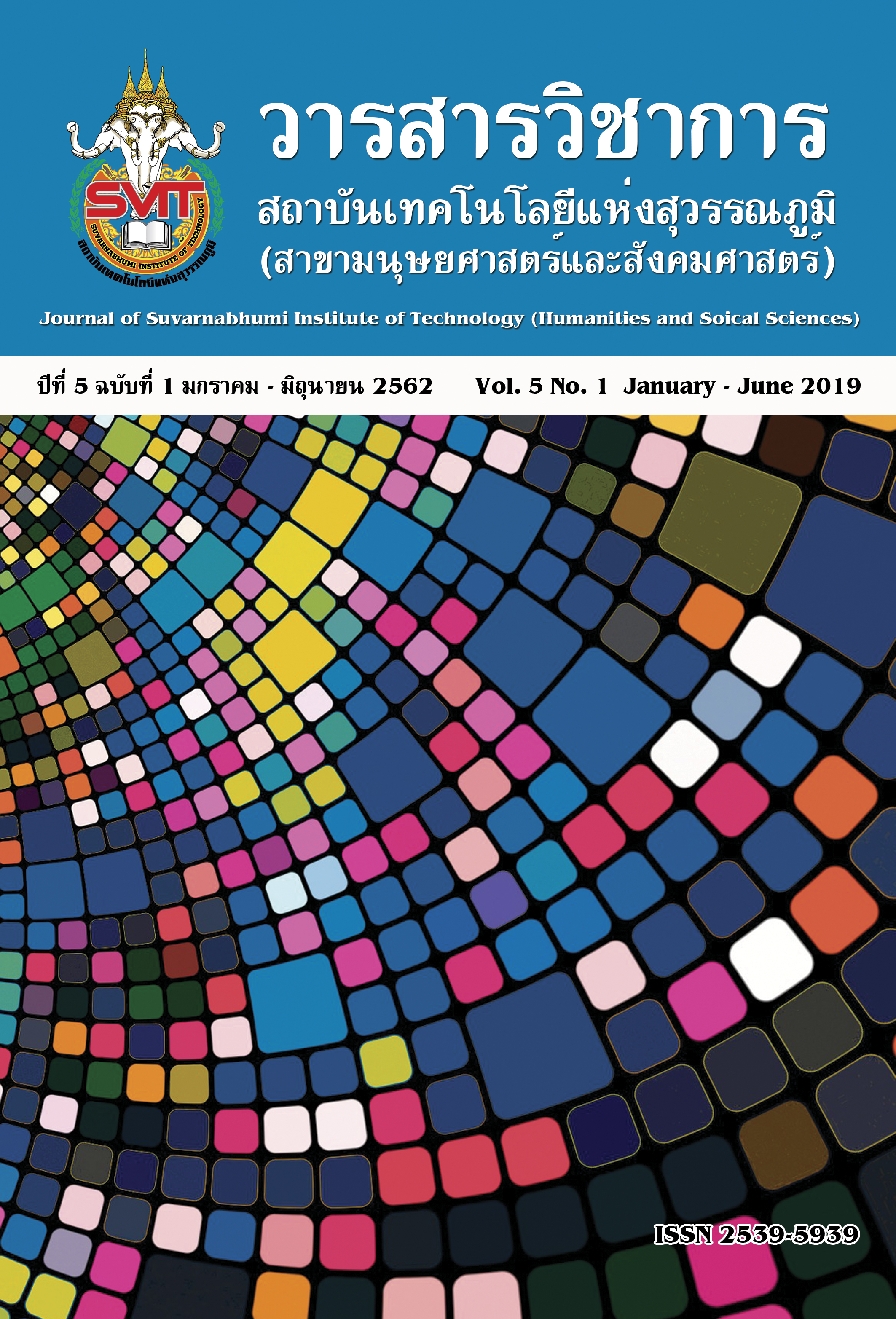CHINESE LEARNING ENVIRONMENT FOR MATHAYOM SUKSA 4 STUDENTS IN THE 21st CENTURY
Keywords:
Chinese Learning Environment, Satisfaction, 21st centuryAbstract
The purposes of this study were: 1) to develop an effective Chinese Learning Environment System for secondary students 2) to compare the pretest score and the posttest score. And 3) to study students’ satisfaction towards Chinese Learning Environment System for Secondary Students. The procedure was divided into 4 stages ; stage1) synthesizing elements and stages of Chinese Learning Environment System for Secondary Students based on experience approach, stage 2) development of Chinese Learning Environment System for Secondary Students based on experience approach, stage 3) investigating the results of the piloting the Chinese Learning Environment System for Secondary Students based on experience approach, and stage 4 ) validate and propose the consultation Chinese Learning Environment System for Secondary Students. The samples were: 1) 6 experts who worked in group discussion to examine the quality of the piloted model
and related documents. 2) 11 teachers who teach Chinese in secondary schools 2. the tools used consisted of 1) the system and its manual 2) the training curriculum 3) the training plan 4) the cognitive, practical skills and attitude competency tests 5) the training website and its manual 6) group discussion questions forms the statistics used were percentage, mean, standard deviation, and dependent samples t-test.
The research finding was summarized as follows: 1. The efficiencies of Chinese learning environment system for secondary students by using web based instruction was 80.11/80.08, which was higher than the set criteria. (80/80) 2. The secondary students who learned through the web based instruction showed higher in the learning achievement than the criteria of 80 percent at the.05 level of significance. 3. The secondary students’ satisfaction toward the web based instruction in overall were at a high level.
References
พ.ศ.2545 พร้อมกฎกระทรวงที่เกี่ยวข้องและพระราชบัญญัติการศึกษาภาคบังคับ พ.ศ.2545. กรุงเทพฯ : โรงพิมพ์ ร.ส.พ.
กระทรวงศึกษาธิการ.(2553). การส่งเสริมการเรียนการสอนภาษาจีน. สืบค้นเมื่อ 18 ตุลาคม 2559,สืบค้น จาก https://www.moe.go.th/moe/th/news/detail.php?NewsID=14859&Key=hotnewsจันทรานี สงวนนาม. (2545). ทฤษฎีและแนวปฏิบัติในการบริหารสถานศึกษา. กรุงเทพฯ: บุ๊คพอยท์
ชัยยงค์ พรหมวงศ์. (2553). ระบบและการจัดระบบ.ในการจัดระบบการศึกษา. ประมวลสำระชุดวิชา 27703 (หน่วยที่ 1-8). นนทบุรี: บัณฑิตวิทยาลัย มหาวิทยาลัยสุโขทัยธรรมาธิราช.
ไชยยศ เรืองสุวรรณ. (2554). การออกแบบและพัฒนาโปรแกรมบทเรียนและบทเรียนบนเว็บ. พิมพ์
ครั้งที่ 15 มหาสารคาม: ภาควิชาเทคโนโลยีและสื่อสารการศึกษา คณะศึกษาศาสตร์ มหาวิทยาลัยมหาสารคาม.
ทรงศักดิ์ ภูสีอ่อน. (2552). การประยุกต์ใช้ SPSS วิเคราะห์ข้อมูลงานวิจัย. พิมพ์ครั้งที่ 3 มหาสารคาม : สำนักพิมพ์มหาวิทยาลัยมหาสารคาม
ทรงศักดิ์ ภูสีอ่อน. (2554). การประยุกต์ใช้ SPSS วิเคราะห์ข้อมูลการวิจัย. พิมพ์ครั้งที่ 4. มหาสารคาม: มหาวิทยาลัยมหาสารคาม
ทิศนา แขมมณี. (2545). ศาสตร์การสอน – องค์ความรู้เพื่อการจัดกระบวนการเรียนรู้ ที่มีประสิทธิภาพ. พิมพ์ครั้งที่.2 กรุงเทพฯ:ด่านสุทธาการพิมพ์
บุญชม ศรีสะอาด. (2545). การวิจัยเบื้องต้น. พิมพ์ครั้งที่ 2. สุวีริยาสาส์น.
ปวีณา เหมะธุลิน. (2551). การสร้างบทเรียนคอมพิวเตอร์มัลติมีเดียเรื่องการถ่ายภาพด้วยกล้องดิจิตอลสำหรับนักศึกษาปริญญาตรี. กรุงเทพฯ: วิทยานิพนธ์ศึกษาศาสตร์มหาบัณฑิต ภาควิชาเทคโนโลยีการศึกษา มหาวิทยาลัยรามคำแหง.
พงศ์ประเสริฐ หกสุวรรณ. (2548). การจัดสภาพแวดล้อมการเรียนรู้. ภาควิชาเทคโนโลยีทางการศึกษา,ชลบุรี มหาวิทยาลัยบูรพา.
สุมาลี ชัยเจริญ. (2545). ทฤษฎีคอนสตรัคติวิซึม. ภาควิชา เทคโนโลยีทางการศึกษา. คณะศึกษาศาสตร์. มหาวิทยาลัยขอนแก่น, 2545.
สุมาลี ชัยเจริญ. (2554). เทคโนโลยีการศึกษา : หลักการ ทฤษฏีสู่การปฏิบัติ. ขอนแก่น : หจก.โรงพิมพ์คลังนานาวิทยา
สุรัตน์ หาญพลาชัย. (2551). ความพึงพอใจของนักเรียน/นักศึกษาที่มีต่อการจัดสภาพแวดล้อมภายใน
วิทยาลัยอาชีวศึกษาชลบุรี. ปริญญาการศึกษามหาบัณฑิต สาขาวิชาการบริหารการศึกษา คณะศึกษาศาสตร์ มหาวิทยาลัยบูรพา.
สุทธิพงศ์ หกสุวรรณ. (2548). การออกแบบและพัฒนาสภาพแวดล้อมทางการศึกษา. เอกสารคำสอนรายวิชาการออกแบบและพัฒนาสภาพแวดล้อมทางการศึกษา. มหาสารคาม: มหาวิทยาลัย มหาสารคาม.
สุวรรณ เลียงหิรัญถาวร . (2551). การจัดการเรียนการสอนภาษาจีนในระดับมัธยมศึกษาตอนปลายของโรงเรียนในจังหวัดเชียงใหม่.กรุงเทพมหานคร : ฐานข้อมูลโครงสร้างพื้นฐานภาครัฐด้านวิทยาศาสตร์และเทคโนโลยี กระทรวงวิทยาศาสตร์และเทคโนโลยี.
Hannanfin M., Susan L. and Kevin O. (1999). Instructional Design Theories and Models: A New Paradigm of Instructional Theory Volume II. New Jersey: Lawrence.
Jonassen H. D. (1999). “Constructivist learning environments”. In Charles M.Reigeluth (Ed),
Instructional Desing Theories And Models: A New Paradigm of Instructional Theory. VolumeII. Newjersy: Lawrence Erlbaum Associates.
Krejcie, Robert V. and Daryle W . Morgan. (1970). (Determining Sample Size for Research Activities Education and Psychological Measurement.November : 607 – 609 .
Lunenburg, C.F. and Ornstein, C.A. (1996). Educational Administration: Concepts and Practices. (2nd edition). California: Wodsworth.
McVey, G.F. (1989). Learning Environments. in The International Encyclopedia of Educational Technology. Edited by M. Eraut. P.124-131. New York: Pergamon Press.
Semprevivo,P.C. (1976). System Analysis:Definition,Process,and Design.Chicago:Science Research Associates.Inc.
Schoderbek,Peter P.and Othors .(1990). Management System: Concetual Consideration. 4 .ed.,Richard D.Irwin,Inc.,6-10
Von Bertalanffy, L. (1968). General System Theory: Foundations, Development, Applications. New York: George Braziller.
Downloads
Published
Issue
Section
License
บทความที่ได้รับการตีพิมพ์เป็นลิขสิทธิ์ของวารสารวิชาการ สถาบันเทคโนโลยีแห่งสุวรรณภูมิ
ข้อความที่ปรากฏในบทความแต่ละเรื่องในวารสารวิชาการเล่มนี้เป็นความคิดเห็นส่วนตัวของผู้เขียนแต่ละท่านไม่เกี่ยวข้องกับสถาบันเทคโนโลยีแห่งสุวรรณภูมิ และคณาจารย์ท่านอื่นๆในสถาบันฯ แต่อย่างใด ความรับผิดชอบองค์ประกอบทั้งหมดของบทความแต่ละเรื่องเป็นของผู้เขียนแต่ละท่าน หากมีความผิดพลาดใดๆ ผู้เขียนแต่ละท่านจะรับผิดชอบบทความของตนเองแต่ผู้เดียว





